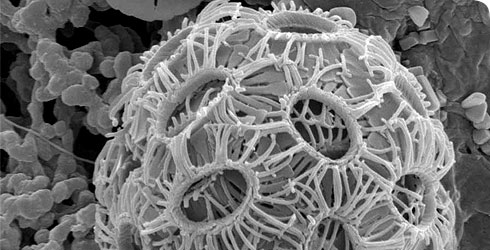Ocean acidification
Emiliania huxleyi has a global population of about 7 x 1022 cells (Emiliani, 1993) scattered across the world ocean and adapted to a wide range of environments. So it should be one of the species least in danger from human activities. Ocean acidification, however, poses a potential threat to all marine organisms which produce calcareous skeletons.
Burning of fossil fuels and deforestation is releasing immense volumes of carbon dioxide into the atmosphere, and around 25% is then dissolved into the sea. This is shifting the chemistry of sea water, making it slightly more acidic and making calcification more difficult.
Organisms such as corals and pteropods (planktonic snails) which produce shells made of aragonite - a less stable calcium carbonate mineral - are likely to be affected by ocean acidification before organisms like coccolithophores which use calcite.
If carbon dioxide emissions are not reduced, however, it is quite possible that by the end of the century even E. huxleyi will be in ecological trouble.
